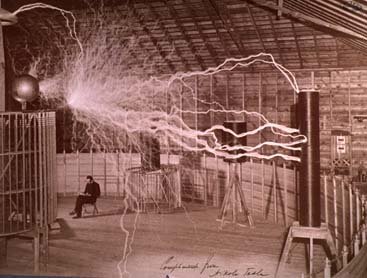Tesla's LabTesla was able to make the improvements he promised, but all the money made went to the investors and all he got were stock certificates.
Later, Mr. A.K. Brown of the Western Union Company invested in Tesla's AC motor idea. A little ways down the street from Thomas Edison's office, Tesla established a small laboratory where he began to work on his motor. The product turned out just exactly as he imagined it while he was working for the telephone company, and soon after the AC generator became the future of power and replaced Edison's DC plants.
Tesla's patents for AC were so novel that they were not met with a single successful challenge. Industrialist George Westinghouse (who invented railroad air brakes) offered $60,000 for the patents and $2.50 of royalties per motor sold. Tesla sold his patents and used half of the money on a new lab.
Over the next few years Tesla was able to put together plans for a power house to be constructed over Niagara Falls, which would provide power all the way up to New York City. The cost of construction, however, so deeply drained the finances of investors (including John Jacob Astor and W.K. Vanderbilt) and both the Westinghouse Corporation and General Electric, Tesla was begged to give up his royalties contract. In a generous gesture, Tesla tore up the contract, which allowed Westinghouse to recover. However, Tesla remained afterwards on the brink of being broke on several occasions up until his death.
Back in his lab, Tesla began experimenting with high frequency and voltage. During this time he produced neon and fluorescent lamps, x-ray photography, and wireless vacuum tube illumination. After the vacuum tube experiment, he became obsessed with the idea of wireless energy transmission.
Using Tesla Coils, he was on the brink of inventing radio by transmitting signals, but a fire in his building destroyed his lab and work. At this time an Italian named Guglielmo Marconi was on his way to being awarded radio patents and later received the Nobel Prize in 1911.
This did not stop Tesla from continuing with invention. He developed the first ideas of robotics (and even built a robotic boat).
Later in 1899 he built a laboratory at Colorado Springs that had a giant 80-foot Tesla coil that he tried to transmit wireless signals at high altitude with, but no record exists that states whether he was successful or not.

Photo of Tesla in his lab at Colorado Springs
www.pbs.orgOne night in his lab, however, Tesla recorded that he picked up signals that he believed to be coming from outer space. If this were at all true, he may have been the first to detect radio waves from space.
Tesla moved back to New York City and was offered $150,000 by a powerful man named J.P. Morgan to construct a transmission tower and power plant that would broadcast wireless news, music, military communications, pictures, and telephone messages across the world. Tesla's real plan was to demonstrate electrical power without wires on a large scale. However, construction of the giant Tesla coil was so expensive that Morgan was not very quick to supply more money. Again Marconi struck by signaling the letter S across the Atlantic. Investors lost interest in Tesla, who then had a nervous breakdown.
Tesla began work on a steam turbine engine that ran at extremely high speeds, but abandoned his project. He withdrew from the world and became recluse. At the beginning of World War I he had an idea of using radio waves to reflect off submarines and appear on a fluorescent screen (what we now call radar) but the idea was too far ahead of his time be considered.

Tesla at age 64
www.pbs.orgIn 1928 at the age of 72 Tesla received his last patent. It was the design for a flying machine very similar to today's vertical short takeoff and landing plane, but he never was able to build a prototype.